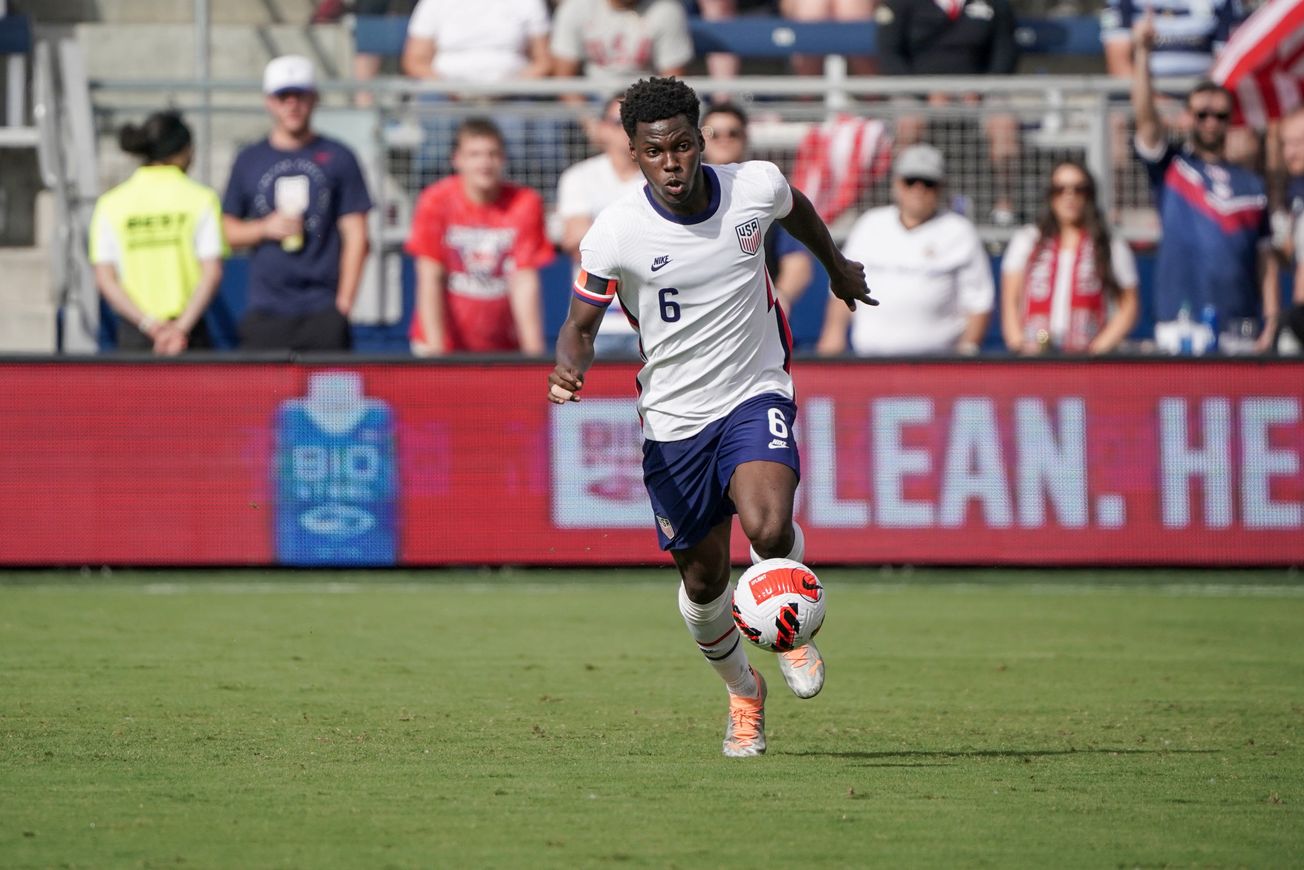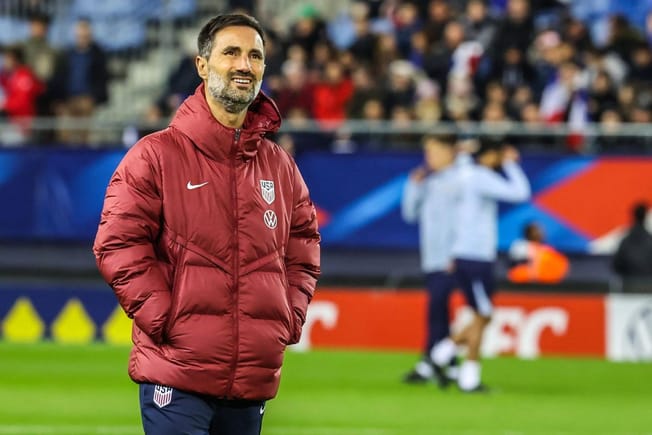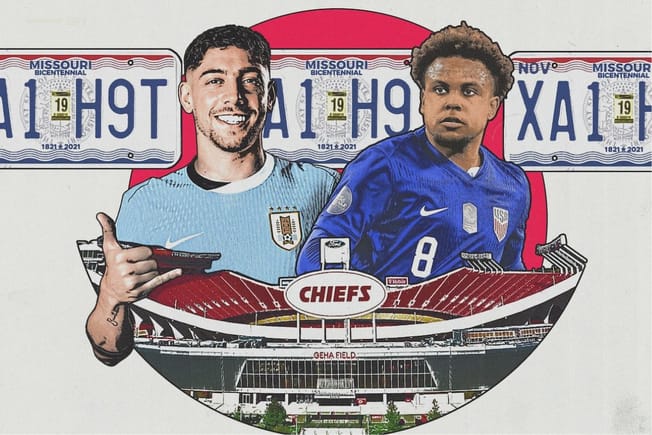Another June game, another chance to learn more about the U.S. men’s national team before the World Cup.
That’s the whole point of this window, right?
This set of four games (of which the United States is now halfway through) is a chance for us to see more and learn more about this young team. The United States put together an imperfect performance in their 0-0 draw with Uruguay on Sunday, but we certainly still learned a few things about this team.
Let’s get into what happened on the field on Sunday.
ANOTHER POSSESSION SHAPE
After the Morocco game, I wrote about how the United States possessed the ball in a 3-2-5 shape, with Reggie Cannon joining the center backs to form a back three in possession. Tyler Adams and Yunus Musah played in a double pivot ahead of that back three and behind the front five.
That three-at-the-back shape wasn’t new under Berhalter, but some of the specifics surrounding that shape were.
Against Uruguay, Berhalter adjusted the tactics yet again, keeping the Adams/Musah double pivot, but using a back four instead of a back three. Weston McKennie moved into the right halfspace in possession, with Tim Weah ahead and slightly to the right of him. On the left side, Christian Pulisic tucked in and Jesus Ferreira shaded to Pulisic’s side to balance out McKennie’s positioning on the right.
Basically, it turned into something resembling a 4-2-2-2 in possession, while still being a 4-3-3 in defense. This passing network from the first half is a great visualization of that 4-2-2-2 shape. Musah (wearing number six) and Adams (whose number is covered by Musah) played on the same line, as did McKennie and Ferreira and then Weah and Pulisic.
#USMNT tilted right in the attacking half, with 77% of touches in the center and right thirds. pic.twitter.com/L8EHEs0fwe
— Paul Carr (@PaulCarr) June 5, 2022
I don’t want to pretend like the USMNT was flawless in that possession shape.
Pushed up into the right halfspace in possession, I don’t think McKennie was as involved as you’d like him to be. The fullbacks, DeAndre Yedlin and Joe Scally, also lacked the quality to truly add value in the attack. Scally struggled in pretty much every phase of play (and that’s okay, he’s a teenager) and Yedlin’s passing let the U.S. down a number of times. His passing accuracy was the lowest of any U.S. starter outside of Aaron Long.
I don’t expect we’ll see Gregg Berhalter use that same set of starting fullbacks in a meaningful game any time soon and I’m also not sure that he’ll be eager to revisit this 4-2-2-2 possession shape any time soon. Still, now that we’ve seen a double pivot in possession in back-to-back games, it wouldn’t surprise me if Berhalter has something in mind involving that shape in the future.
Why? Because in certain situations, having another player next to Tyler Adams in buildup can help the U.S. progress the ball more effectively.
*Yunus Musah enters, stage left*
MUSAH LIGHTENS ADAMS’ LOAD
If there’s one player who helped the U.S. progress the ball through Uruguay’s defensive shape more than anybody else, it was Musah. Playing a similar, deep-lying role to the one he played against Morocco, Musah gave Uruguay fits with his skill on the ball.
Now, it’s worth mentioning that this wasn’t a full-strength Uruguay team. Diego Alonso rotated his starting XI after their recent friendly against Mexico. Even with that rotated lineup, it was pretty clear that Uruguay still had quality players on the field. Musah waltzed through those quality players over and over and over again.
By setting up deeper in the midfield, Musah, who is supremely comfortable under pressure, took a lot of the responsibility in possession off of Adams’ shoulders. He completed more dribbles than any other player on the field on Sunday and strung together a bunch of sequences pretty much just like this one, where he collects the ball from deep and advances it quickly.
“Yunus is a guy that just blows me away, at his age, what he can do – crazy level of talent,” Berhalter said after the game.
He really is an incredible talent. And he’s an asset in possession for the U.S. specifically because of how expertly he moves the ball upfield. Now, there is room for Musah to improve his game. Let’s roll that second half of that Berhalter quote:
“We need to work with Yunus on his final product, the final pass, the finishing because he has a huge ceiling.”
Ah, there it is. You can see it in the above clip. Musah bets on himself to get out of a tight spot, but then once he’s out of that tight spot, he holds onto the ball for a little too long. Pulisic wanted the ball between the lines in that 2nd minute clip, but Musah didn’t give it to him.
I will say, Musah did a nice job of releasing the ball and helping the USMNT with his passing in addition to his dribbling at times against Uruguay. This clip from the 29th minute is a great example of that. As Ben Wright says, though, it would be great to see more of that kind of thing from Musah.
As a teenager, Musah has some room to grow. But because of how good he can be on the ball, I will be very, very surprised if we don’t see him in another double pivot in possession at some point in the not too distant future.
ODDS AND ENDS
Sean Johnson didn’t have a ton of shot-stopping to do for the U.S., but he came up big in this moment in the 63rd minute. As a goalkeeper, being in the right place at the right time is a big part of the job.
Johnson also had some nice moments with the ball at his feet. With Matt Turner and Zack Steffen likely to both be warming the bench for their Premier League teams in the fall, the door is open for someone like Johnson to play his way onto the World Cup roster. And maybe, just maybe, Johnson can do a little bit more than that.
I really enjoyed watching Christian Pulisic and Tim Weah in this game. Both made their mark in the attack. Pulisic was relatively decisive with the ball at his feet, combining with McKennie and registering a game-high four key passes. Weah’s directness on the right wing helped stretch Uruguay and force them back. Neither Weah nor Pulisic created an absurd number of super high quality chances in this game, but both players caused problems for the opponents.
Heading into Friday’s game against Grenada in the Concacaf Nations League, it’s time to rotate the starting XI. Grenada, ranked 170 in the FIFA rankings and 174 in the World Football Elo Ratings, isn’t a very dangerous opponent, so it feels to me like Friday will be another chance to for Berhalter to give minutes to younger or less experienced options.
Here’s my preferred U.S. lineup for that game:
GK: Horvath
RB: Cannon
CB: Cameron Carter-Vickers
CB: Erik Palmer-Brown
LB: Joe Scally
CDM: Acosta
CM: de la Torre
CM: Roldan
RW: Arriola
LW: Tillman
ST: Wright







Comments